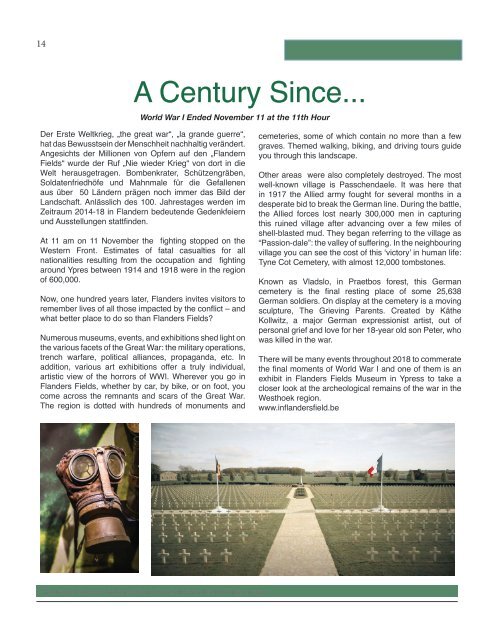Das Schwarze Brett - Issue 5
Das Schwarze Brett is a German Canadian Magazine for German-speakers on the west coast of Canada and the US. It shares what is going on in the Austrian, German & Swiss communities of new, first, second and third generation Germans.
Das Schwarze Brett is a German Canadian Magazine for German-speakers on the west coast of Canada and the US. It shares what is going on in the Austrian, German & Swiss communities of new, first, second and third generation Germans.
You also want an ePaper? Increase the reach of your titles
YUMPU automatically turns print PDFs into web optimized ePapers that Google loves.
14<br />
A Century Since...<br />
World War I Ended November 11 at the 11th Hour<br />
Der Erste Weltkrieg, „the great war“, „la grande guerre“,<br />
hat das Bewusstsein der Menschheit nachhaltig verändert.<br />
Angesichts der Millionen von Opfern auf den „Flandern<br />
Fields“ wurde der Ruf „Nie wieder Krieg“ von dort in die<br />
Welt herausgetragen. Bombenkrater, Schützengräben,<br />
Soldatenfriedhöfe und Mahnmale für die Gefallenen<br />
aus über 50 Ländern prägen noch immer das Bild der<br />
Landschaft. Anlässlich des 100. Jahrestages werden im<br />
Zeitraum 2014-18 in Flandern bedeutende Gedenkfeiern<br />
und Ausstellungen stattfinden.<br />
At 11 am on 11 November the fighting stopped on the<br />
Western Front. Estimates of fatal casualties for all<br />
nationalities resulting from the occupation and fighting<br />
around Ypres between 1914 and 1918 were in the region<br />
of 600,000.<br />
Now, one hundred years later, Flanders invites visitors to<br />
remember lives of all those impacted by the conflict – and<br />
what better place to do so than Flanders Fields?<br />
Numerous museums, events, and exhibitions shed light on<br />
the various facets of the Great War: the military operations,<br />
trench warfare, political alliances, propaganda, etc. In<br />
addition, various art exhibitions offer a truly individual,<br />
artistic view of the horrors of WWI. Wherever you go in<br />
Flanders Fields, whether by car, by bike, or on foot, you<br />
come across the remnants and scars of the Great War.<br />
The region is dotted with hundreds of monuments and<br />
cemeteries, some of which contain no more than a few<br />
graves. Themed walking, biking, and driving tours guide<br />
you through this landscape.<br />
Other areas were also completely destroyed. The most<br />
well-known village is Passchendaele. It was here that<br />
in 1917 the Allied army fought for several months in a<br />
desperate bid to break the German line. During the battle,<br />
the Allied forces lost nearly 300,000 men in capturing<br />
this ruined village after advancing over a few miles of<br />
shell-blasted mud. They began referring to the village as<br />
“Passion-dale”: the valley of suffering. In the neighbouring<br />
village you can see the cost of this ‘victory’ in human life:<br />
Tyne Cot Cemetery, with almost 12,000 tombstones.<br />
Known as Vladslo, in Praetbos forest, this German<br />
cemetery is the final resting place of some 25,638<br />
German soldiers. On display at the cemetery is a moving<br />
sculpture, The Grieving Parents. Created by Käthe<br />
Kollwitz, a major German expressionist artist, out of<br />
personal grief and love for her 18-year old son Peter, who<br />
was killed in the war.<br />
There will be many events throughout 2018 to commerate<br />
the final moments of World War I and one of them is an<br />
exhibit in Flanders Fields Museum in Ypress to take a<br />
closer look at the archeological remains of the war in the<br />
Westhoek region.<br />
www.inflandersfield.be<br />
©Westcoast German News publishes <strong>Das</strong> <strong>Schwarze</strong> <strong>Brett</strong> 6 times a year



